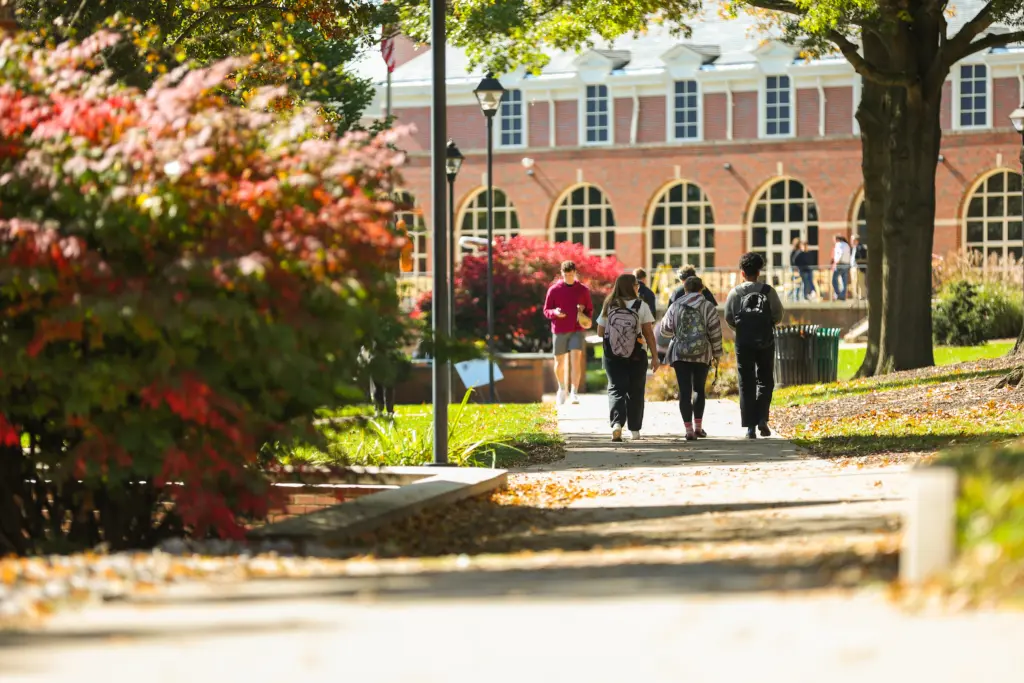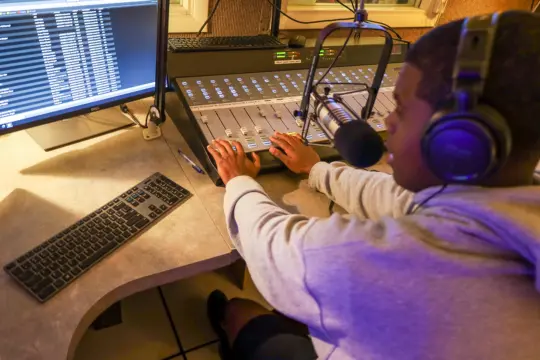Sports Media
Learning to make sports stories jump off the page and the screen.
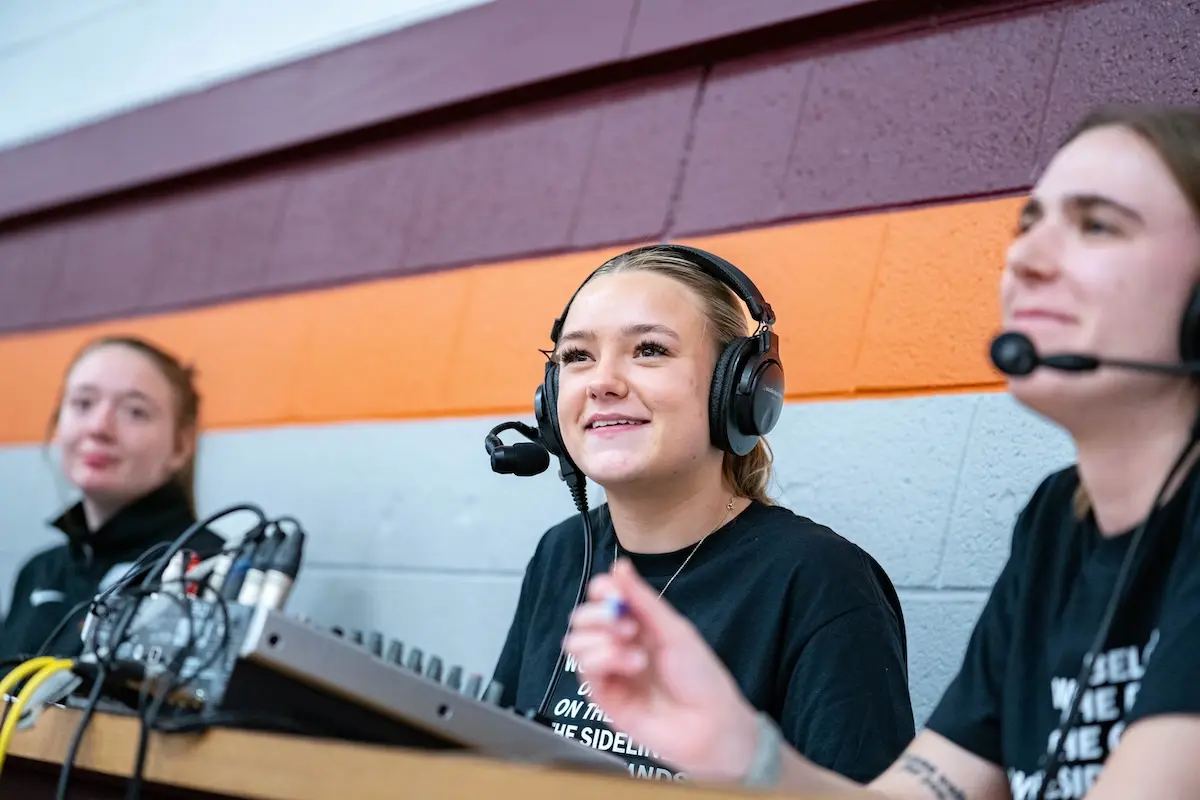
Sports Media Degree
Sports media is exploding. Jobs in this area are expected to grow by 13% by 2031. As a sports media major at Susquehanna University, you will gain professional skills and be part of the action from day one, narrating a play-by-play livestream of Saturday’s big game or hosting your own sports radio show. You will practice your sports broadcasting skills behind the mic while learning about sports journalism, communications and management in the classroom.
With proximity to Philadelphia, New York City, Washington, D.C., and Baltimore, Susquehanna University offers you the chance to meet and collaborate with all kinds of teams. And, sometimes the experts come to you! Meet sports media professionals hosted on campus who provide insights and recommendations on getting the most out of your studies and experiences.
- Take a behind-the-scenes tour of the Philadelphia Eagles’ operation, hosted by a Susquehanna alumnus.
- Network at the Baseball Winter Meetings or attend an Association for Women in Sports Media convention.
- Broadcast live from Susquehanna University River Hawks’ athletic events.
The latest technologies at your fingertips ensure that you’re ready for when doors open for you. You’ll have access to our award-winning radio station, a state-of-the-art video production studio, a modern podcast production suite, a student-run campus newspaper dedicated to extensive sports coverage and an athletic communications office that mentors students through jobs and internships.
Shape the Future
of Sports Media, your way
Our sports media students have several opportunities for hands-on broadcasting experience — behind the mic, behind the camera, behind the script or behind the scenes producing and editing for our own River Hawks Network. Sportscasting careers begin at Susquehanna.
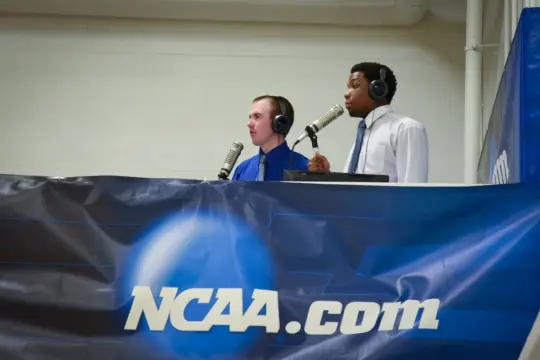
SUSQUEHANNA By the Numbers
More Than Metrics
4+
student-led sports productions per week
4+
sports media professional guests per semester
5+
hands-on, on-campus sports media opportunities for students
#1
rated student radio station in Pennsylvania
Explore Your Studies
Program Resources
This course is an introduction to the industry standard software package for professional designers and communicators. Students will focus on core concepts and techniques that apply to work flow in Photoshop, InDesign, Acrobat Pro and Illustrator. The course emphasizes basic design principles, visual literacy and the technical skills necessary to develop effective designs for print, web and other applications. 2 SH
An introduction to journalism. Topics include American newspaper history, elements of libel, copyediting symbols, Associated Press style, news leads, inverted pyramid format, interviewing, attributing quotations, writing stories on speeches and meetings, and reading print and online newspapers critically. 4 SH. CC: Writing Intensive.
The foundational course in the sports media program. The course instructs students on the basics of writing sports stories, primarily game summaries for print media, such as newspapers and websites. Other topics include feature stories, column writing, interviewing technique and Associated Press style. Attention is also given to writing game stories for broadcast media, such as television and radio, as well as writing for blogs and other new media platforms. 2 SH.
Offers instruction on how to compute statistics for a variety of sports. Includes the use of statistical software, as well as reflection on how to properly apply statistics in reporting and interpreting athletic contests. Students will also examine the growing use of analytics in sports and how it has changed the industry. 2 SH.
Introduces students to the $500 billion-plus sports industry, with emphasis on career opportunities and the professional viewpoints and skills needed to succeed in this area. Students draw on business, marketing and communication principles to learn how to plan sports events and manage sports businesses/clients. 2 SH.
An introductory exploration of theories about communication and mass media, with particular emphasis on how the media shapes public discourse and drives understanding. Consideration is given to how media conveys power dynamics and reinforces or challenges stereotypes, often via aesthetic choices about how a story is presented. The course also explores some non-media theories, including theories about human interaction. 2 SH.
An introductory course on competent interpersonal communication skills. Topics include setting specific communication goals; ways we perceive, talk and listen to others; gender communication; how we use verbal and nonverbal communication; skills in relationships; and ethical considerations within the contexts of friendships, families, intimate partnerships and the workplace. 4 SH. CC: Social Interactions.
Basic principles of effective extemporaneous speaking to inform and persuade an audience. Emphasizes audience analysis, idea development, organization and delivery skills. Students deliver, listen to and criticize classroom speeches. 4 SH.
An introduction to contemporary and foundational concepts, practices and processes of intercultural communication. Topics include the complex nature of social and cultural identities; privilege, power and oppression in historical and contemporary society; representations of cultures and identities in popular media; nonverbal codes and cultural space; and the relationship between language and culture. Special emphasis will be on ethical and mindful intercultural communication and social justice. 4 SH. CC: Diversity.
Uses case studies to examine the types of ethical challenges that face professional communicators across a variety of contexts, while requiring students to analyze those situations critically. The role of leadership in navigating ethical dilemmas is highlighted, as are several case studies where ethical questions intersect with diversity-related issues. 4 SH. CC: Diversity Intensive, Ethics Intensive.
This course focuses on performance metrics for strategic communication on the internet. Students will examine contemporary practices, learn analytic software and its application, optimize websites and social media, and study how businesses use analytics to tailor content and target audiences in strategic digital communication. Prerequisite: COMM-101. CC: Analytical Thought. 4 SH.
This course introduces students to the fields of advertising and public relations, along with fundamental concepts and theories behind effective advertising and public relations practices. The course will provide students with a solid foundation for understanding both disciplines, including historic and contemporary perspectives, ethical and legal issues, best practices, job opportunities, and the components of successful advertising and public relations campaigns. 4 SH
This course is intended to provide students with a practical understanding of the principles of selling, the sales process and the experiences and skills essential to become successful at selling. The course will also explore selling careers and various sales structures and compensation options. 4 SH
The theory and practice of news writing and content creation for print, web and social media. Topics include news sources, news selection, covering beats, basic photojournalism and ethical reporting. Prerequisite: COMM-131 and COMM-202. 4 SH.
Introduces students to the public relations function within the sports industry, especially the media relations position common to professional teams, leagues and university athletic programs. Students learn how to write news releases and arrange news conferences, in addition to learning about media guide assembly, press box management and promotion of sports and athletes via social media. 2 SH.
Introduces students to the elements of play-by-play announcing, color analysis and in-studio hosting, with instruction in each. Attention is also given to the differences between announcing for visual media versus radio. On-air interviewing technique is also covered. Students also learn about the history of sports broadcasting. 2 SH.
Provides students practice with two specialized types of sports writing: feature writing, which is a longer, magazine-style writing form that profiles and humanizes athletes, and column writing, which provides opinion or analysis and drives much of today’s online sports readership. 2 SH.
Examines the theory and practice of audio production and broadcast operations, including sound and broadcast wave theory, console operation, microphone techniques, commercial production, digital editing and on-air procedures. Students will produce broadcast-quality audio projects in addition to developing a working knowledge and appreciation for high-quality sound and video production. Includes an examination and study of basic announcing techniques for audio and video, such as voice and diction, pronunciation and oral interpretation of American speech for broadcast and online distribution. Prerequisite: COMM-101 or COMM-102. 4 SH.
An introduction to small to medium format video production. Covers basic equipment, terminology, personnel and video production techniques in the studio and field. Includes writing, producing and editing of assigned short projects such as commercials or brief interview segments. Prerequisite: COMM-101 or COMM-102. 4 SH.
Introduction to qualitative research methods that contribute to the insight and depth of our understanding of communication. Focuses on qualitative research methods including in-depth interviewing, focus groups, case studies, participant observation and textual analysis. Students will design and conduct an exploratory qualitative study and write a scholarly essay answering a communication question using qualitative research methods. Prerequisites: COMM-101 or COMM-102 and COMM-190. May be taken concurrently with COMM-202. 4 SH. CC: Writing Intensive
This course introduces students to primary and secondary research methods used to develop solutions to advertising and public relations problems. Students will explore the most important and relevant research methods used by advertising and public relations practitioners to define target audiences, inform strategic planning and message development, and evaluate strategic communication plans and campaigns. Students will develop capabilities in planning and conducting research, as well as interpreting and communicating the findings. Prerequisites: COMM-211. 4 SH
Students will demonstrate competency in producing various pieces of written material commonly used in the public relations field, conducting a public relations campaign and understanding professionalism (attendance, deadlines and appropriate use of electronic devices). The course will be a combination of learning to generate public relations materials in a variety of formats as well as utilizing research methodologies, creative strategies and evaluative techniques to create a fully-developed public relations campaign. 4 SH.
This course seeks to develop students’ sales skills and knowledge of the selling process to a professional and competitive level. Students improve their professional selling skills through role-playing projects and a real-world sale. The top students will have the opportunity to compete in sales competitions. Team selling will also be introduced. The course is appropriate for students seeking to further their understanding and skill in selling and the sales process. Prerequisite: COMM 215. 4 SH
This course is designed to provide students with basic planning, designing, writing and production techniques involved in the development of advertising creative work. Students will use copywriting and design skills, computer software programs, segmentation, targeting and positioning strategies to reach audiences to complete advertising campaigns that include print and broadcast ads, direct mail pieces and digital advertising. The use of typography, color, graphics and other design tools will be used to target these creative messages. Students will also submit a final digital portfolio of their creative work that demonstrates proficiency in the skills and techniques covered in the course. Prerequisites: COMM-102 and COMM-211. 4 SH
In today’s world, crises are inevitable. Crisis management recognizes and deals with systems and system failures. This course introduces the students to a management approach for working with crises before, during and after they occur. Communications-related elements and challenges are especially emphasized. Prerequisite: sophomore standing. 4 SH.
Strategic Event Management will prepare students to research, plan, execute and evaluate small and large scale events. Students will acquire in-depth knowledge of special event planning processes, techniques and strategies while creating communication products essential to the planning process, including logistical, promotional and evaluative materials. 4 SH.
The process of editing news for print and online outlets. Includes developing assignments, editorial judgment and ethical considerations, copy-editing, type styles and sizes, headline writing, graphic and photo design, and page layout. Prerequisite: COMM-131 or ENGL-190. 4 SH.
Introduces and expands student knowledge to the art and practice of contemporary media criticism and key theoretical and critical approaches, focusing on interactive digital media, including gaming and simulation technologies. Students will gain a deeper understanding of the movement and interconnection that exists between new media technologies and their social, economic, cultural and political impacts and effects. Historical development, industrial structure and organization, and effects of convergent and emergent media will be incorporated into the analysis. Prerequisite: COMM-190. 4 SH. CC: Writing Intensive.
An emphasis on advanced video editing techniques and special effects utilizing Adobe Premiere Pro editing software. Students edit and produce complete programs and projects from field-recorded video and student-recorded productions. Emphasis will be on both the technical operation of sophisticated editing systems and the aesthetics of program editing. Students will be required to engage the web as a system for distribution of content and will be expected to produce and create their own personal web pages and portfolio blogs. Prerequisites: COMM-277 and COMM-282. 4 SH.
Introduces students to the planning, in-game decision-making and overall precision that are required to mount a broadcast or livestream of a sporting event or sports studio show. Emphasis is placed on production and scripting considerations that make sports distinct from news and other entertainment programs. 2 SH.
An introduction to the theory and practice of writing for video and emerging media, and the planning required for production. Students will learn the fundamentals of visual writing, as well as the integration of visual elements into scenes and short scripts to be prepared for production. 4 SH Prerequisite: COMM-282.
This course will introduce motion graphics and animation techniques using 2D and 3D computer software. Theoretical and conceptual approaches to motion graphics design and techniques will be explored. Students will complete several animation projects with increasing complexity during the course. Prerequisites: sophomore standing; COMM-282. 2 SH.
Theory and principles of effective team membership and leadership in the small group setting. Focuses on functional roles, verbal and nonverbal behaviors, decision making, problem solving, conflict resolution, ethics and diversity and group dynamics through the observations of teams. Capstone for Communication Arts. 4 SH.
Modules include management, strategy, government affairs and corporate advertising. Self-managed teams simulate agency communications consulting. Prerequisites: Second-semester junior or senior standing, COMM-211 and COMM-314. Capstone for Public Relations. 4 SH. CC: Team Intensive.
This course is a faculty-guided independent study overviewing student achievement in academic work in the Communications Department, including aspects of professional sales and skill development in creative work, writing, research, ethics and critical thinking. This course is a reflective and forward-looking experience with content derived from the student’s academic experiences both in the classroom and in practice-based learning. Participation in this course will provide students with a method of completing their capstone requirements by (1) preparing a communications portfolio of the student’s best communications work and presenting it in a mock interview with a faculty advisor and (2) preparing a reflective essay to look back on the student’s undergraduate experience, intellectual and professional growth, and progress. Prerequisites: junior or senior standing, COMM-315 and COMM-505. Capstone. 2 SH.
This capstone course provides students the opportunity to plan, execute and present a complete advertising campaign for a client. Students, working in agency-style teams, apply both theoretical and practical knowledge acquired in their previous coursework to complete the campaign. Prerequisites: junior standing, and either COMM-311 and COMM-317 or major in the Sigmund Weis School of Business and MKTG. Capstone for Advertising and Public Relations. 4 SH
The process of determining a medium’s audience, developing story ideas, writing query letters, and researching and writing feature articles. How-to’s, profiles, and travel and human interest articles are among the assignments. Students prepare and print online portfolios. Prerequisites: junior or senior standing and COMM-131 or COMM-141. Capstone for journalism, communication arts or sports media. 4 SH.
Examines legal aspects of print and electronic communications. Emphasizes First Amendment, freedom of the press, the right to know, copyright, libel and privacy. Prerequisite: senior standing. 4 SH. CC: Interdisciplinary, Writing Intensive.
Engages students in the advanced methods of digital multimedia production. Students will produce a variety of projects that demonstrate their understanding of production skills, including audio and video production for broadcast and the web. Students will be required to maintain personal portfolio blogs that showcase content produced in this course and others. Students will gain an understanding of the ethical and theoretical frameworks of video broadcasting. Prerequisites: senior standing and COMM-382. Capstone for Broadcasting or Sports Media. 4 SH.
A survey of contemporary theories of social media that focuses on how social media affects individuals, communities and cultures in the world of athletics. Particular attention will be paid to themes such as identity, privacy, access, participatory culture and attention economies. Students will be able to evaluate and analyze how social media impacts social, economic and civic lives. Students will simultaneously learn about careers in social media, including social media strategy, content creation, user experience, analytics and data science. A primary goal of this course is to create a professional production environment for sports media majors, where student teams will produce real-world digital media projects under the instructor’s supervision. Prerequisites: COMM-202, COMM-383 and senior standing. Capstone. 4 SH.
The capstone course brings together student work from various classes, emphasizing especially their research, analytical, interpretive, communication and writing skills. Students create a substantial research project in conjunction with a faculty member and present their work publicly. Required for Communication Studies majors. Prerequisites: COMM-202, COMM-291, senior standing, or instructor’s permission. 4 SH. Capstone for Communication Studies. CC: Writing Intensive.
Examines selected topics in communications, depending on instructor and student interest. Course may be repeated for credit if the topic is different. 2-4 SH.
The communications practicum is a supervised practical application of knowledge in a given area of study – journalism, public relations, radio, video and sports. The practicum presents unique opportunities that go beyond traditional classroom learning, allowing students to fully understand aspects of their chosen field or explore others. All department majors and minors must complete the number of semester hours required by their degree. Students may take no more than two hours of practicum credit in one semester. The maximum number of total practicum hours a student may take is six. Practicum projects generally require 60 hours of work per semester. Prerequisite: sophomore standing. 1 SH
In-depth exploration of selected topics in advertising and public relations, broadcasting, communication studies, journalism and digital content, or sports media with faculty guidance. This course option allows students to focus on topics outside the normal sequence of course offerings. Prerequisite: Department-designated faculty director’s permission and approval from department head. May be repeated but not for departmental major credit. 1-4 SH.
Independent study for candidates accepted into the departmental honors program. Candidates work under faculty direction, develop and submit a written or production theses, and defend their theses orally. 4 SH.
On-the-job supervised experience at a corporation, governmental agency or nonprofit organization. Prerequisites: junior or senior standing and permission from the internship coordinator and the department head. 1-8 SH.
This course provides students in the Professional Sales major an opportunity to apply the skills and knowledge of the sales discipline learned in the classroom to the professional setting by working within a sales-oriented organization. Prerequisites: Program/Internship coordinator’s approval and acceptance by the organization. Graded on a Satisfactory/Unsatisfactory basis. 0-4 SH.
When you enroll at Susquehanna, you’ll be paired with an advisor and application tool to guide you in your course planning and scheduling. The following is an excerpt from the complete course catalog. Enrolled students follow the requirements of the course catalog for the academic year in which they declare each major and/or minor, consult with their advisor(s).
Learning Goals
- Students will be able to identify, explain and apply theory.
- Students will demonstrate communication skills (oral, visual, written, research).
- Students will recognize ethical implications and relate them to various contexts.
- Students will develop and practice critical thinking.
Major in Communications
Susquehanna offers five degrees in Communications: advertising and public relations; broadcasting; communication studies; journalism and digital content; and sports media. Majors complete university’s Central Curriculum requirements, plus 48 to 50 semester hours of courses in a selected degree plan. These include introductory courses, practica for learning skills, and specific emphasis requirements. A grade of C- or better is required for any course to apply to the major or minor. Courses may count toward only one degree or minor.
The department also expects communications majors and minors to participate each semester in related co-curricular activities. Options include WQSU-FM radio, The Quill student newspaper, The Lanthorn student yearbook, studio and remote video production with Lens Flare, the Paul Dannelley Chapter of the Public Relations Student Society of America (PRSSA), the Association for Women in Sports Media (AWSM), and other activities supervised by department faculty.
Sports Media Track
Students prepare for careers in sports media and/or sports public relations/promotion by fulfilling the university’s Central Curriculum requirements, participating in sports-related communications practica, and completing the following courses:
24 Department Requirements
- 4 COMM-101 Essentials of Digital Media
- 2 COMM-102 Methods of Adobe Creative Suite
- 2 COMM-190 Intro to Communication/Media Theory
- 4 COMM-192 Public Speaking
- 4 COMM-201 Ethics and Leadership
- 4 COMM-202 Digital Media Analytics
- 4 COMM-481 Media Law
22 Sports Media Requirements
- 2 COMM-141 Sports Reporting
- 2 COMM-142 Sports Statistics
- 2 COMM-241 Sports Media Relations and Promotion
- 2 COMM-242 Sports Announcing
- 4 COMM-282 Fundamentals of Digital Video Production
- 1 COMM-501 Practicum
- 1 COMM-501 Practicum
In addition to the courses above, a student must complete one of the following course sequences which each total 12 SH:
- COMM-277 Audio Production and Media Performance; COMM-382 Intermediate Digital Multimedia Production; COMM-482 Professional Digital Multimedia Production
- COMM 143-Sports Management; COMM 243-Sports Feature Writing and Column Writing; COMM 383-Sports Production; COMM 386-Motion Graphics and Animation; COMM 483-Sports and Social Media
Honors
The departmental honors program encourages and recognizes outstanding performance in communications. To graduate with department honors, candidates must do the following:
- Complete major requirements under the guidance of a Communications Department faculty adviser, who agrees to serve as a sponsor at the student’s request.
- Petition the honors coordinator with a written honors proposal no later than the second-to-last week of the end of the junior year. The submission must be approved as honors quality by the departmental faculty.
- Maintain a 3.70 cumulative GPA in department courses.
- Produce an acceptable written or production thesis based on one year of senior research/production work (COMM-503 Honors Study) beyond the required major track semester hours.
- Submit the thesis at least two weeks before graduation.
- Successfully complete an oral defense of the honors thesis.
Honors work not meeting the required standards will be applied as a university elective course. Departmental honors may be taken separately from or in conjunction with the university Honors Program.
Honor Societies
Students who meet the requisite national and local standards are eligible to join the national honorary society Lamda Pi Eta (communications).
Communications Minors
Courses selected require a grade of C- or higher.
Double-Counting Restriction
Courses may count toward only one Communications degree or minor.
When you enroll at Susquehanna, you’ll be paired with an advisor and application tool to guide you in your course planning and scheduling. The following is an excerpt from the complete course catalog. Enrolled students follow the requirements of the course catalog for the academic year in which they declare each major and/or minor and consult with their advisor(s).
Students are expected to participate in department activities appropriate to their interests and complete a total of 24 credit hours:
- COMM-101 Essentials of Digital Media
- COMM-102 Methods of Adobe Creative Suite
- COMM-141 Sports Reporting
- COMM-142 Sports Statistics
- COMM-241 Sports Media Relations and Promotion
- COMM-242 Sports Announcing
- COMM-277 Audio Production and Media Performance
- COMM-282 Fundamentals of Digital Video Production
- Two semesters of COMM-501 Practicum
- Sports radio host
- Play-by-play announcer
- Sports team social media coordinator
- Sports team community relations director
- Sports video content producer
Where Passion Meets Purpose
Straight from the Nest


“Getting involved on this campus is something that’s a ‘must’ in my opinion. Whether you’re on a sports team, a part of a club, or in a fraternity or sorority, it makes the atmosphere and your experience at Susquehanna that much better.”
— Jaxson Purnell ’25
“Susquehanna University’s sports media program truly gave me the skills, connections and confidence I need to succeed in my career.”
— Kirsten Hatton ’19
national women in sports media chapter of the year
Less than five years after being established, Susquehanna University’s chapter of the Association for Women in Sports Media has been named the 2023 Student Chapter of the Year by the national organization.
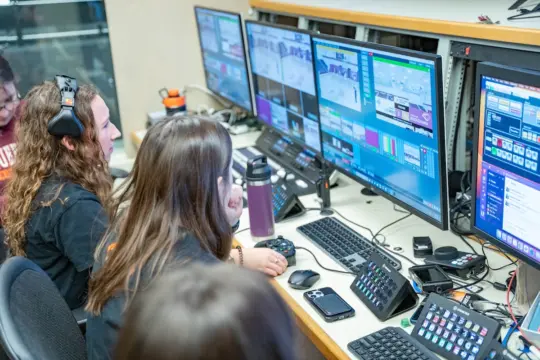
Meet the Faculty
YOU MAY ALSO BE INTERESTED IN
See the full list of related programs on the School of Humanities page.
Have Questions?
Contact Us
Start your journey.
